Development Economics Report: Sustainable Development Analysis
VerifiedAdded on 2021/02/18
|40
|5596
|468
Report
AI Summary
This report delves into the complexities of development economics, examining the influences of macro and microeconomic factors on inequality and sustainability. It explores the challenges of development policy, the strengths and limitations of classic indices like GDP and HDI, and the modern indicator of happiness. The report analyzes the middle-income trap in China, comparing the development statuses of the European Union, the United States, and China. It discusses economic development theories, trends in development, and the impact of the UN's sustainable goals. The report further appraises BRICS nations and provides a detailed analysis of various considerations impacting international development, offering a comprehensive overview of economic development challenges and strategies.
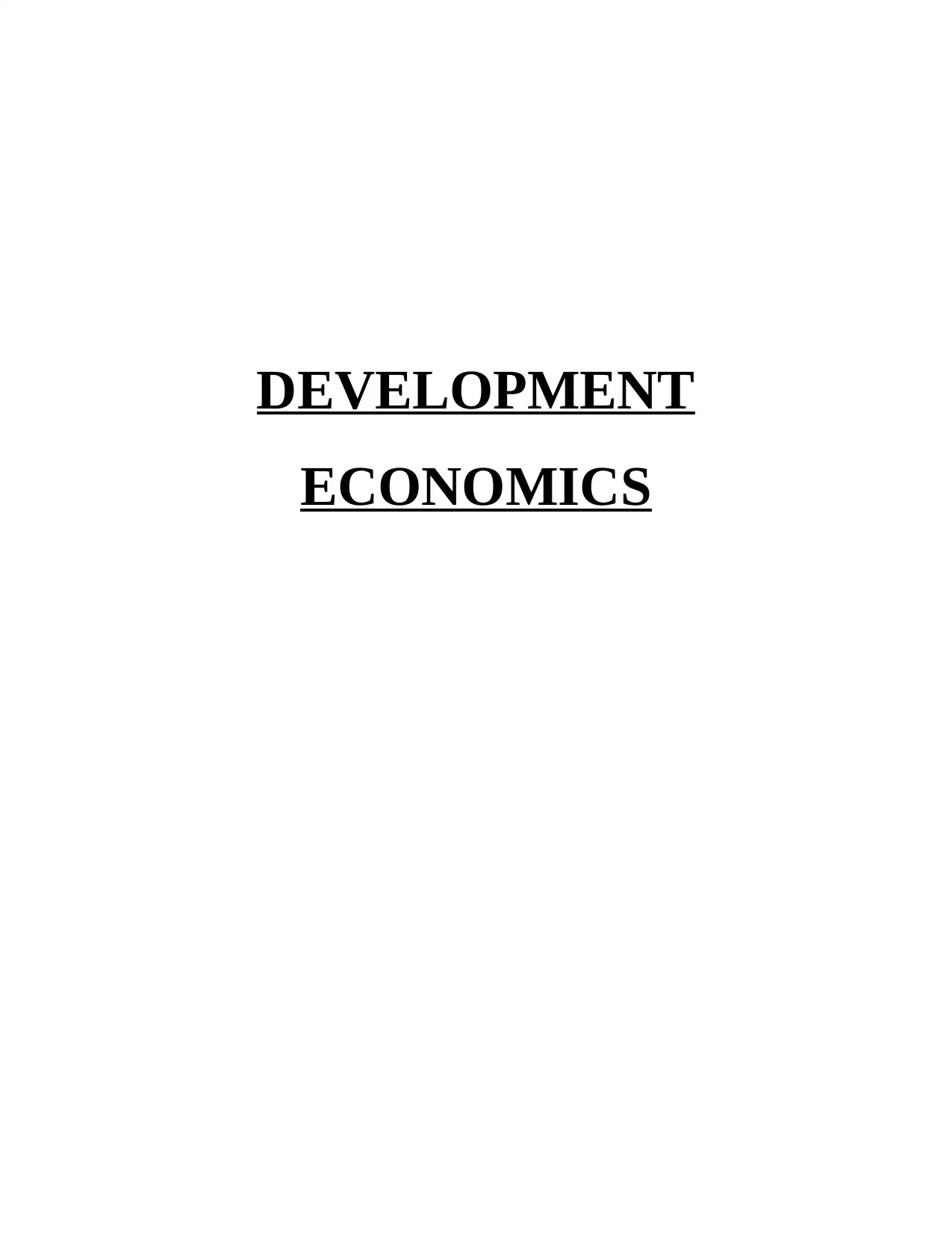
DEVELOPMENT
ECONOMICS
ECONOMICS
Paraphrase This Document
Need a fresh take? Get an instant paraphrase of this document with our AI Paraphraser
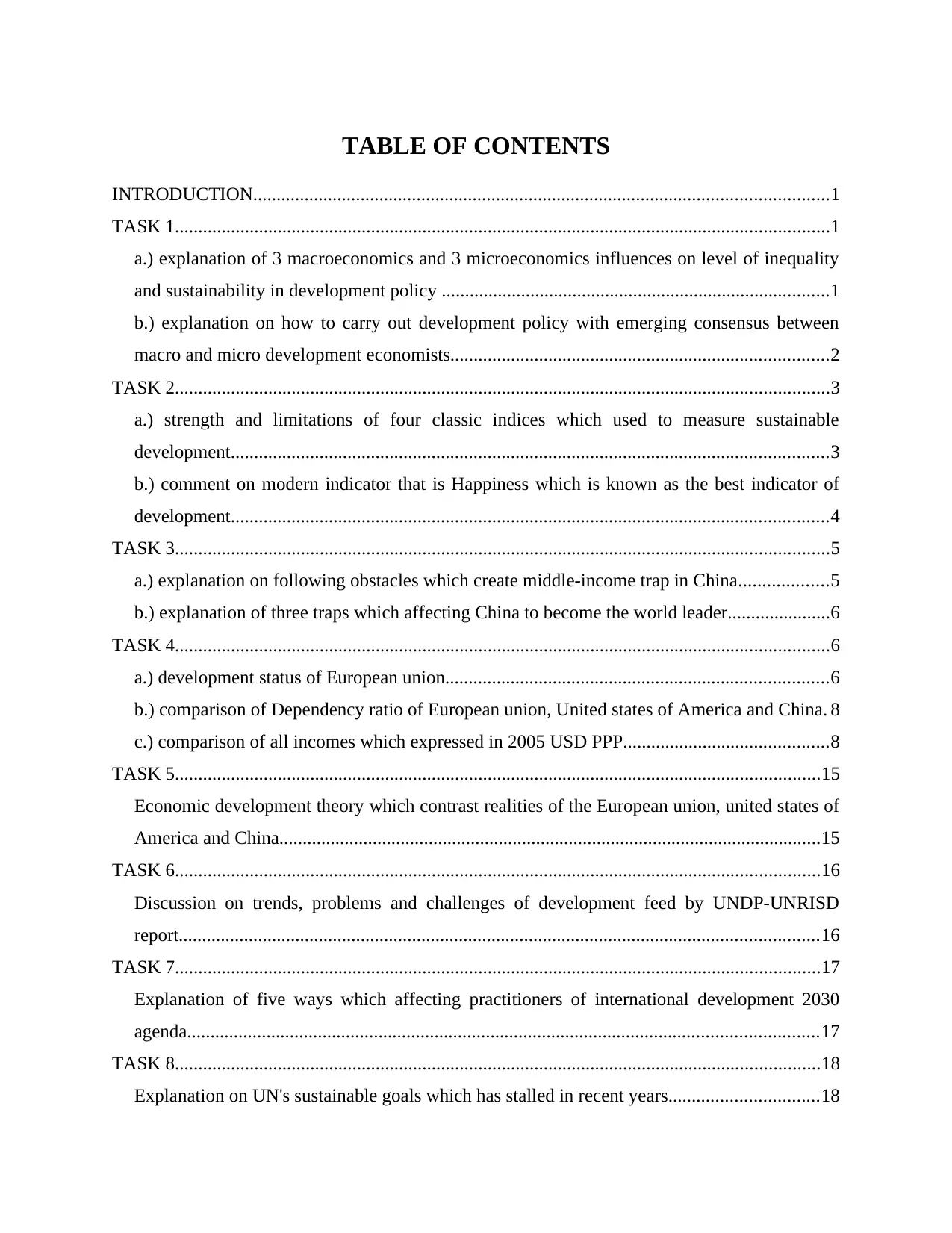
TABLE OF CONTENTS
INTRODUCTION...........................................................................................................................1
TASK 1............................................................................................................................................1
a.) explanation of 3 macroeconomics and 3 microeconomics influences on level of inequality
and sustainability in development policy ...................................................................................1
b.) explanation on how to carry out development policy with emerging consensus between
macro and micro development economists.................................................................................2
TASK 2............................................................................................................................................3
a.) strength and limitations of four classic indices which used to measure sustainable
development................................................................................................................................3
b.) comment on modern indicator that is Happiness which is known as the best indicator of
development................................................................................................................................4
TASK 3............................................................................................................................................5
a.) explanation on following obstacles which create middle-income trap in China...................5
b.) explanation of three traps which affecting China to become the world leader......................6
TASK 4............................................................................................................................................6
a.) development status of European union..................................................................................6
b.) comparison of Dependency ratio of European union, United states of America and China. 8
c.) comparison of all incomes which expressed in 2005 USD PPP............................................8
TASK 5..........................................................................................................................................15
Economic development theory which contrast realities of the European union, united states of
America and China....................................................................................................................15
TASK 6..........................................................................................................................................16
Discussion on trends, problems and challenges of development feed by UNDP-UNRISD
report.........................................................................................................................................16
TASK 7..........................................................................................................................................17
Explanation of five ways which affecting practitioners of international development 2030
agenda.......................................................................................................................................17
TASK 8..........................................................................................................................................18
Explanation on UN's sustainable goals which has stalled in recent years................................18
INTRODUCTION...........................................................................................................................1
TASK 1............................................................................................................................................1
a.) explanation of 3 macroeconomics and 3 microeconomics influences on level of inequality
and sustainability in development policy ...................................................................................1
b.) explanation on how to carry out development policy with emerging consensus between
macro and micro development economists.................................................................................2
TASK 2............................................................................................................................................3
a.) strength and limitations of four classic indices which used to measure sustainable
development................................................................................................................................3
b.) comment on modern indicator that is Happiness which is known as the best indicator of
development................................................................................................................................4
TASK 3............................................................................................................................................5
a.) explanation on following obstacles which create middle-income trap in China...................5
b.) explanation of three traps which affecting China to become the world leader......................6
TASK 4............................................................................................................................................6
a.) development status of European union..................................................................................6
b.) comparison of Dependency ratio of European union, United states of America and China. 8
c.) comparison of all incomes which expressed in 2005 USD PPP............................................8
TASK 5..........................................................................................................................................15
Economic development theory which contrast realities of the European union, united states of
America and China....................................................................................................................15
TASK 6..........................................................................................................................................16
Discussion on trends, problems and challenges of development feed by UNDP-UNRISD
report.........................................................................................................................................16
TASK 7..........................................................................................................................................17
Explanation of five ways which affecting practitioners of international development 2030
agenda.......................................................................................................................................17
TASK 8..........................................................................................................................................18
Explanation on UN's sustainable goals which has stalled in recent years................................18
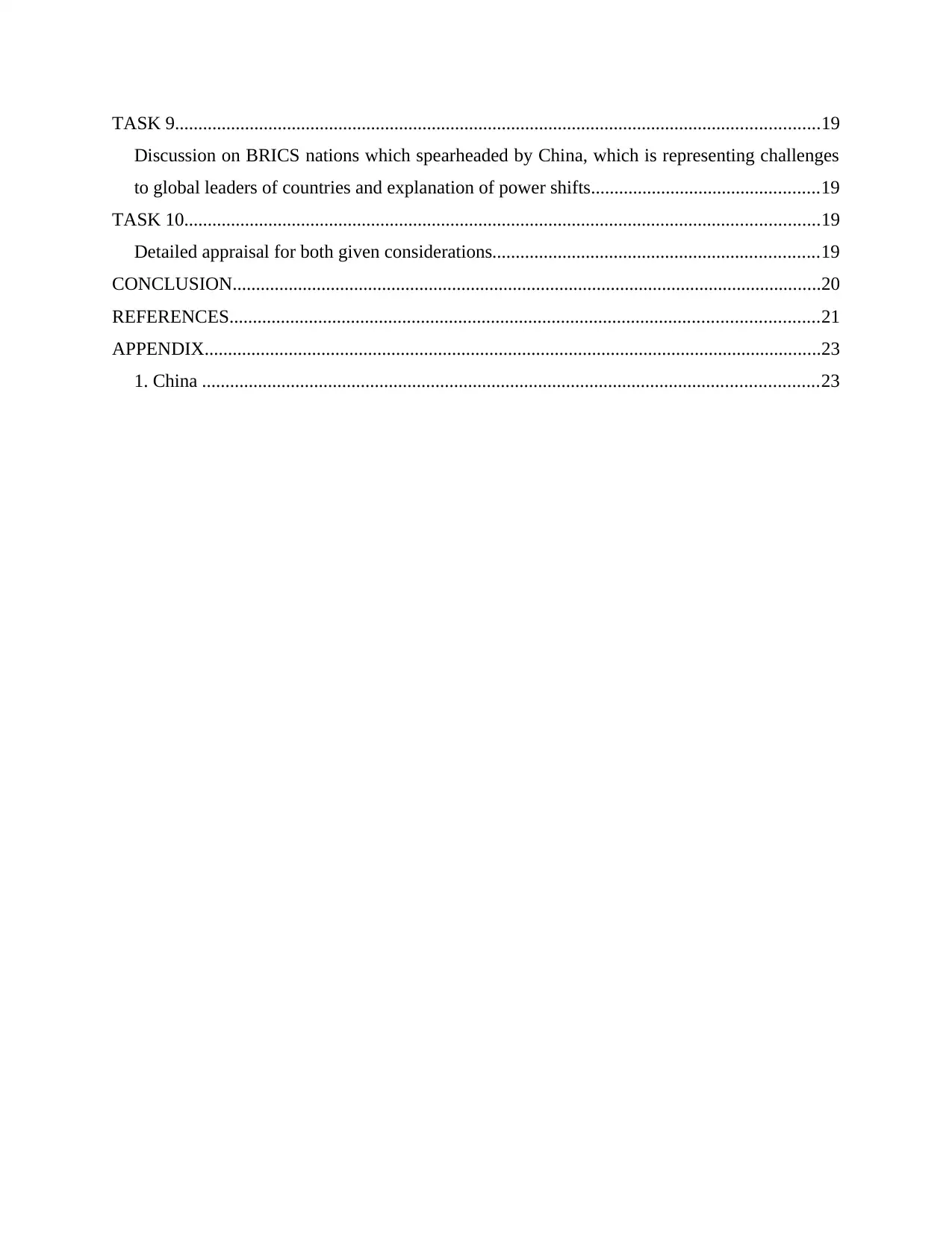
TASK 9..........................................................................................................................................19
Discussion on BRICS nations which spearheaded by China, which is representing challenges
to global leaders of countries and explanation of power shifts.................................................19
TASK 10........................................................................................................................................19
Detailed appraisal for both given considerations......................................................................19
CONCLUSION..............................................................................................................................20
REFERENCES..............................................................................................................................21
APPENDIX....................................................................................................................................23
1. China ....................................................................................................................................23
Discussion on BRICS nations which spearheaded by China, which is representing challenges
to global leaders of countries and explanation of power shifts.................................................19
TASK 10........................................................................................................................................19
Detailed appraisal for both given considerations......................................................................19
CONCLUSION..............................................................................................................................20
REFERENCES..............................................................................................................................21
APPENDIX....................................................................................................................................23
1. China ....................................................................................................................................23
⊘ This is a preview!⊘
Do you want full access?
Subscribe today to unlock all pages.

Trusted by 1+ million students worldwide
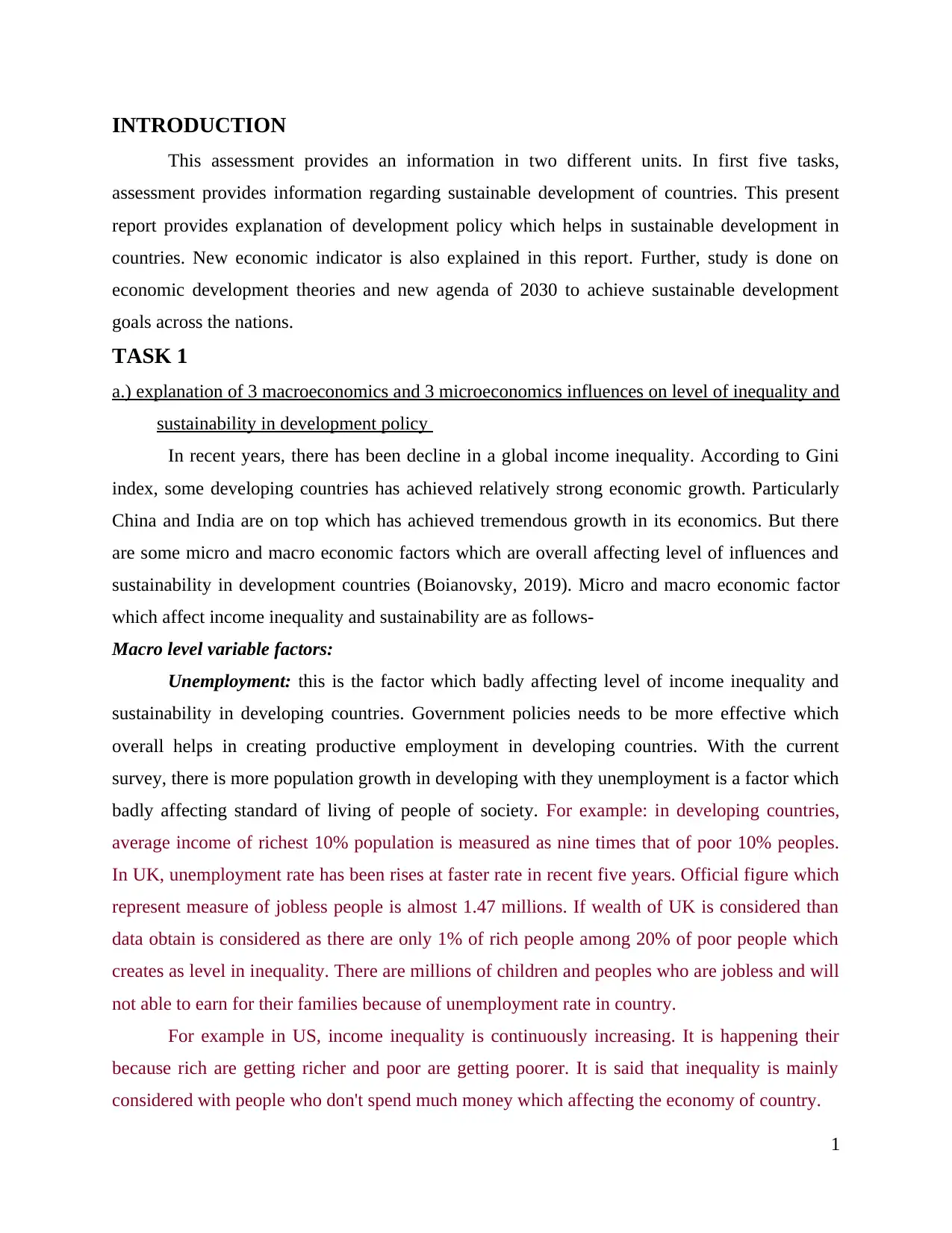
INTRODUCTION
This assessment provides an information in two different units. In first five tasks,
assessment provides information regarding sustainable development of countries. This present
report provides explanation of development policy which helps in sustainable development in
countries. New economic indicator is also explained in this report. Further, study is done on
economic development theories and new agenda of 2030 to achieve sustainable development
goals across the nations.
TASK 1
a.) explanation of 3 macroeconomics and 3 microeconomics influences on level of inequality and
sustainability in development policy
In recent years, there has been decline in a global income inequality. According to Gini
index, some developing countries has achieved relatively strong economic growth. Particularly
China and India are on top which has achieved tremendous growth in its economics. But there
are some micro and macro economic factors which are overall affecting level of influences and
sustainability in development countries (Boianovsky, 2019). Micro and macro economic factor
which affect income inequality and sustainability are as follows-
Macro level variable factors:
Unemployment: this is the factor which badly affecting level of income inequality and
sustainability in developing countries. Government policies needs to be more effective which
overall helps in creating productive employment in developing countries. With the current
survey, there is more population growth in developing with they unemployment is a factor which
badly affecting standard of living of people of society. For example: in developing countries,
average income of richest 10% population is measured as nine times that of poor 10% peoples.
In UK, unemployment rate has been rises at faster rate in recent five years. Official figure which
represent measure of jobless people is almost 1.47 millions. If wealth of UK is considered than
data obtain is considered as there are only 1% of rich people among 20% of poor people which
creates as level in inequality. There are millions of children and peoples who are jobless and will
not able to earn for their families because of unemployment rate in country.
For example in US, income inequality is continuously increasing. It is happening their
because rich are getting richer and poor are getting poorer. It is said that inequality is mainly
considered with people who don't spend much money which affecting the economy of country.
1
This assessment provides an information in two different units. In first five tasks,
assessment provides information regarding sustainable development of countries. This present
report provides explanation of development policy which helps in sustainable development in
countries. New economic indicator is also explained in this report. Further, study is done on
economic development theories and new agenda of 2030 to achieve sustainable development
goals across the nations.
TASK 1
a.) explanation of 3 macroeconomics and 3 microeconomics influences on level of inequality and
sustainability in development policy
In recent years, there has been decline in a global income inequality. According to Gini
index, some developing countries has achieved relatively strong economic growth. Particularly
China and India are on top which has achieved tremendous growth in its economics. But there
are some micro and macro economic factors which are overall affecting level of influences and
sustainability in development countries (Boianovsky, 2019). Micro and macro economic factor
which affect income inequality and sustainability are as follows-
Macro level variable factors:
Unemployment: this is the factor which badly affecting level of income inequality and
sustainability in developing countries. Government policies needs to be more effective which
overall helps in creating productive employment in developing countries. With the current
survey, there is more population growth in developing with they unemployment is a factor which
badly affecting standard of living of people of society. For example: in developing countries,
average income of richest 10% population is measured as nine times that of poor 10% peoples.
In UK, unemployment rate has been rises at faster rate in recent five years. Official figure which
represent measure of jobless people is almost 1.47 millions. If wealth of UK is considered than
data obtain is considered as there are only 1% of rich people among 20% of poor people which
creates as level in inequality. There are millions of children and peoples who are jobless and will
not able to earn for their families because of unemployment rate in country.
For example in US, income inequality is continuously increasing. It is happening their
because rich are getting richer and poor are getting poorer. It is said that inequality is mainly
considered with people who don't spend much money which affecting the economy of country.
1
Paraphrase This Document
Need a fresh take? Get an instant paraphrase of this document with our AI Paraphraser

Level of inequality with unemployment is mainly occurring in developing countries of
nation. According to a statistics, in India unemployment rate is increasing with 18.6 million and
in China number of unemployment rate is increase with 37.6 million. This data shows that there
is huge level of income inequality in countries across the nation.
Poverty: this is the another factor which also influencing level of inequality and
sustainability in developing countries. According to survey it is indicated that about 162 million
peoples across the world living in ultra poverty. For example: in UK, there are approx 25.3% of
population living under the poverty line which is the huge data that shows level on income
inequality in UK. Compared to other developed countries of nation, there is a high level of
income inequality. As there are less jobs people are not able to earn for their families by which
poverty in UK is substantially increasing. Economic growth of country does not affect poverty
but it is affecting standard of people living which overall affect growth of country.
Poverty is the factor which has almost affected all countries of nation. US is also one
among them. According to survey, it is found that there one-quarter of American workers which
earning less than $10 per hour a day which creates a huge level in income inequality. Developed
economy is showing that rich people getting richer and poor people getting poorer by which in
equal income distribution is not reducing in countries.
Demographic changes: changes demographically in countries majorly influencing level
of inequality and sustainability. Demographic change directly affect GDP growth of country
(Tamura and et.al., 2019). Increase or decrease in GDP will majorly affect income level,
accumulation level, prices of goods, inflation in countries etc. for example:- There are various
changes which took place in UK like technological changes, education changes which have
majorly created unequal distribution of income, where skilled worker are getting higher income
in comparison to unskilled workers. This difference in pay scale in workers at same stage of
work is majorly creating unequal income distribution which overall affecting economic
development of country.
Income inequality in US has increased with past 30 years. It is because income
distribution in country in unequal which means that those who are at top of income spectrum are
getting higher income as compared to people who have less income earning. With current
changes like technology, trade and institutions are the main factors which creating level of
2
nation. According to a statistics, in India unemployment rate is increasing with 18.6 million and
in China number of unemployment rate is increase with 37.6 million. This data shows that there
is huge level of income inequality in countries across the nation.
Poverty: this is the another factor which also influencing level of inequality and
sustainability in developing countries. According to survey it is indicated that about 162 million
peoples across the world living in ultra poverty. For example: in UK, there are approx 25.3% of
population living under the poverty line which is the huge data that shows level on income
inequality in UK. Compared to other developed countries of nation, there is a high level of
income inequality. As there are less jobs people are not able to earn for their families by which
poverty in UK is substantially increasing. Economic growth of country does not affect poverty
but it is affecting standard of people living which overall affect growth of country.
Poverty is the factor which has almost affected all countries of nation. US is also one
among them. According to survey, it is found that there one-quarter of American workers which
earning less than $10 per hour a day which creates a huge level in income inequality. Developed
economy is showing that rich people getting richer and poor people getting poorer by which in
equal income distribution is not reducing in countries.
Demographic changes: changes demographically in countries majorly influencing level
of inequality and sustainability. Demographic change directly affect GDP growth of country
(Tamura and et.al., 2019). Increase or decrease in GDP will majorly affect income level,
accumulation level, prices of goods, inflation in countries etc. for example:- There are various
changes which took place in UK like technological changes, education changes which have
majorly created unequal distribution of income, where skilled worker are getting higher income
in comparison to unskilled workers. This difference in pay scale in workers at same stage of
work is majorly creating unequal income distribution which overall affecting economic
development of country.
Income inequality in US has increased with past 30 years. It is because income
distribution in country in unequal which means that those who are at top of income spectrum are
getting higher income as compared to people who have less income earning. With current
changes like technology, trade and institutions are the main factors which creating level of
2
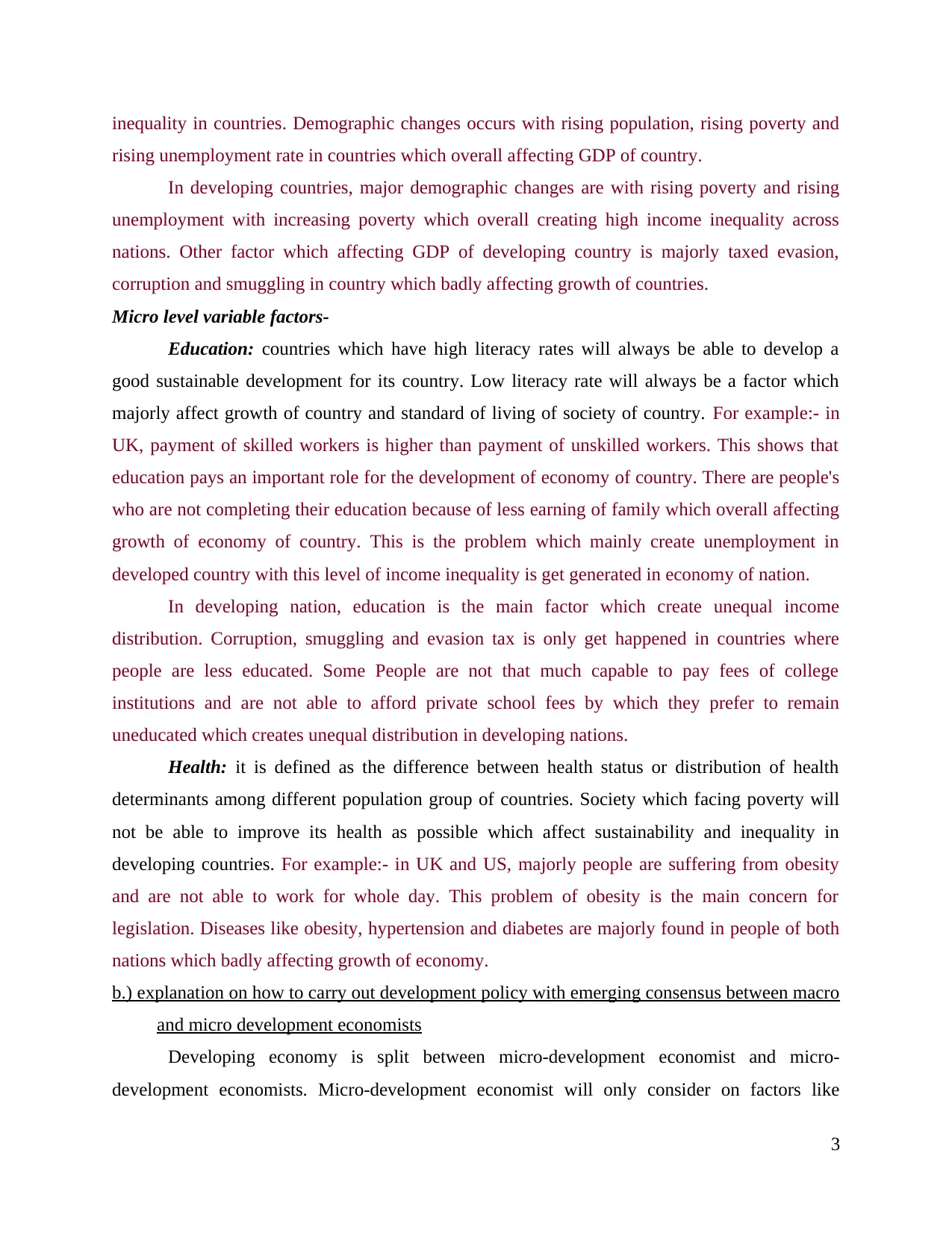
inequality in countries. Demographic changes occurs with rising population, rising poverty and
rising unemployment rate in countries which overall affecting GDP of country.
In developing countries, major demographic changes are with rising poverty and rising
unemployment with increasing poverty which overall creating high income inequality across
nations. Other factor which affecting GDP of developing country is majorly taxed evasion,
corruption and smuggling in country which badly affecting growth of countries.
Micro level variable factors-
Education: countries which have high literacy rates will always be able to develop a
good sustainable development for its country. Low literacy rate will always be a factor which
majorly affect growth of country and standard of living of society of country. For example:- in
UK, payment of skilled workers is higher than payment of unskilled workers. This shows that
education pays an important role for the development of economy of country. There are people's
who are not completing their education because of less earning of family which overall affecting
growth of economy of country. This is the problem which mainly create unemployment in
developed country with this level of income inequality is get generated in economy of nation.
In developing nation, education is the main factor which create unequal income
distribution. Corruption, smuggling and evasion tax is only get happened in countries where
people are less educated. Some People are not that much capable to pay fees of college
institutions and are not able to afford private school fees by which they prefer to remain
uneducated which creates unequal distribution in developing nations.
Health: it is defined as the difference between health status or distribution of health
determinants among different population group of countries. Society which facing poverty will
not be able to improve its health as possible which affect sustainability and inequality in
developing countries. For example:- in UK and US, majorly people are suffering from obesity
and are not able to work for whole day. This problem of obesity is the main concern for
legislation. Diseases like obesity, hypertension and diabetes are majorly found in people of both
nations which badly affecting growth of economy.
b.) explanation on how to carry out development policy with emerging consensus between macro
and micro development economists
Developing economy is split between micro-development economist and micro-
development economists. Micro-development economist will only consider on factors like
3
rising unemployment rate in countries which overall affecting GDP of country.
In developing countries, major demographic changes are with rising poverty and rising
unemployment with increasing poverty which overall creating high income inequality across
nations. Other factor which affecting GDP of developing country is majorly taxed evasion,
corruption and smuggling in country which badly affecting growth of countries.
Micro level variable factors-
Education: countries which have high literacy rates will always be able to develop a
good sustainable development for its country. Low literacy rate will always be a factor which
majorly affect growth of country and standard of living of society of country. For example:- in
UK, payment of skilled workers is higher than payment of unskilled workers. This shows that
education pays an important role for the development of economy of country. There are people's
who are not completing their education because of less earning of family which overall affecting
growth of economy of country. This is the problem which mainly create unemployment in
developed country with this level of income inequality is get generated in economy of nation.
In developing nation, education is the main factor which create unequal income
distribution. Corruption, smuggling and evasion tax is only get happened in countries where
people are less educated. Some People are not that much capable to pay fees of college
institutions and are not able to afford private school fees by which they prefer to remain
uneducated which creates unequal distribution in developing nations.
Health: it is defined as the difference between health status or distribution of health
determinants among different population group of countries. Society which facing poverty will
not be able to improve its health as possible which affect sustainability and inequality in
developing countries. For example:- in UK and US, majorly people are suffering from obesity
and are not able to work for whole day. This problem of obesity is the main concern for
legislation. Diseases like obesity, hypertension and diabetes are majorly found in people of both
nations which badly affecting growth of economy.
b.) explanation on how to carry out development policy with emerging consensus between macro
and micro development economists
Developing economy is split between micro-development economist and micro-
development economists. Micro-development economist will only consider on factors like
3
⊘ This is a preview!⊘
Do you want full access?
Subscribe today to unlock all pages.

Trusted by 1+ million students worldwide
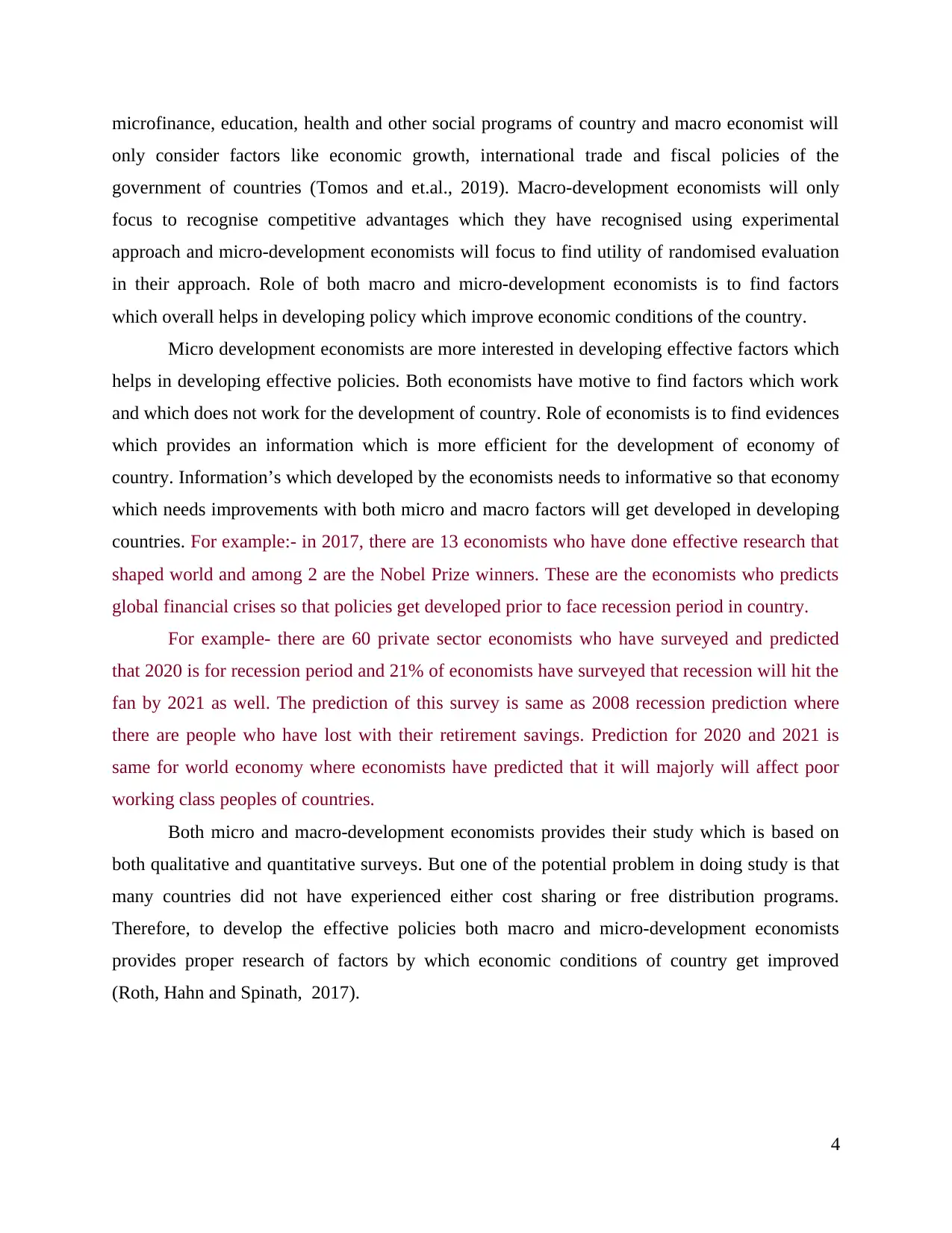
microfinance, education, health and other social programs of country and macro economist will
only consider factors like economic growth, international trade and fiscal policies of the
government of countries (Tomos and et.al., 2019). Macro-development economists will only
focus to recognise competitive advantages which they have recognised using experimental
approach and micro-development economists will focus to find utility of randomised evaluation
in their approach. Role of both macro and micro-development economists is to find factors
which overall helps in developing policy which improve economic conditions of the country.
Micro development economists are more interested in developing effective factors which
helps in developing effective policies. Both economists have motive to find factors which work
and which does not work for the development of country. Role of economists is to find evidences
which provides an information which is more efficient for the development of economy of
country. Information’s which developed by the economists needs to informative so that economy
which needs improvements with both micro and macro factors will get developed in developing
countries. For example:- in 2017, there are 13 economists who have done effective research that
shaped world and among 2 are the Nobel Prize winners. These are the economists who predicts
global financial crises so that policies get developed prior to face recession period in country.
For example- there are 60 private sector economists who have surveyed and predicted
that 2020 is for recession period and 21% of economists have surveyed that recession will hit the
fan by 2021 as well. The prediction of this survey is same as 2008 recession prediction where
there are people who have lost with their retirement savings. Prediction for 2020 and 2021 is
same for world economy where economists have predicted that it will majorly will affect poor
working class peoples of countries.
Both micro and macro-development economists provides their study which is based on
both qualitative and quantitative surveys. But one of the potential problem in doing study is that
many countries did not have experienced either cost sharing or free distribution programs.
Therefore, to develop the effective policies both macro and micro-development economists
provides proper research of factors by which economic conditions of country get improved
(Roth, Hahn and Spinath, 2017).
4
only consider factors like economic growth, international trade and fiscal policies of the
government of countries (Tomos and et.al., 2019). Macro-development economists will only
focus to recognise competitive advantages which they have recognised using experimental
approach and micro-development economists will focus to find utility of randomised evaluation
in their approach. Role of both macro and micro-development economists is to find factors
which overall helps in developing policy which improve economic conditions of the country.
Micro development economists are more interested in developing effective factors which
helps in developing effective policies. Both economists have motive to find factors which work
and which does not work for the development of country. Role of economists is to find evidences
which provides an information which is more efficient for the development of economy of
country. Information’s which developed by the economists needs to informative so that economy
which needs improvements with both micro and macro factors will get developed in developing
countries. For example:- in 2017, there are 13 economists who have done effective research that
shaped world and among 2 are the Nobel Prize winners. These are the economists who predicts
global financial crises so that policies get developed prior to face recession period in country.
For example- there are 60 private sector economists who have surveyed and predicted
that 2020 is for recession period and 21% of economists have surveyed that recession will hit the
fan by 2021 as well. The prediction of this survey is same as 2008 recession prediction where
there are people who have lost with their retirement savings. Prediction for 2020 and 2021 is
same for world economy where economists have predicted that it will majorly will affect poor
working class peoples of countries.
Both micro and macro-development economists provides their study which is based on
both qualitative and quantitative surveys. But one of the potential problem in doing study is that
many countries did not have experienced either cost sharing or free distribution programs.
Therefore, to develop the effective policies both macro and micro-development economists
provides proper research of factors by which economic conditions of country get improved
(Roth, Hahn and Spinath, 2017).
4
Paraphrase This Document
Need a fresh take? Get an instant paraphrase of this document with our AI Paraphraser
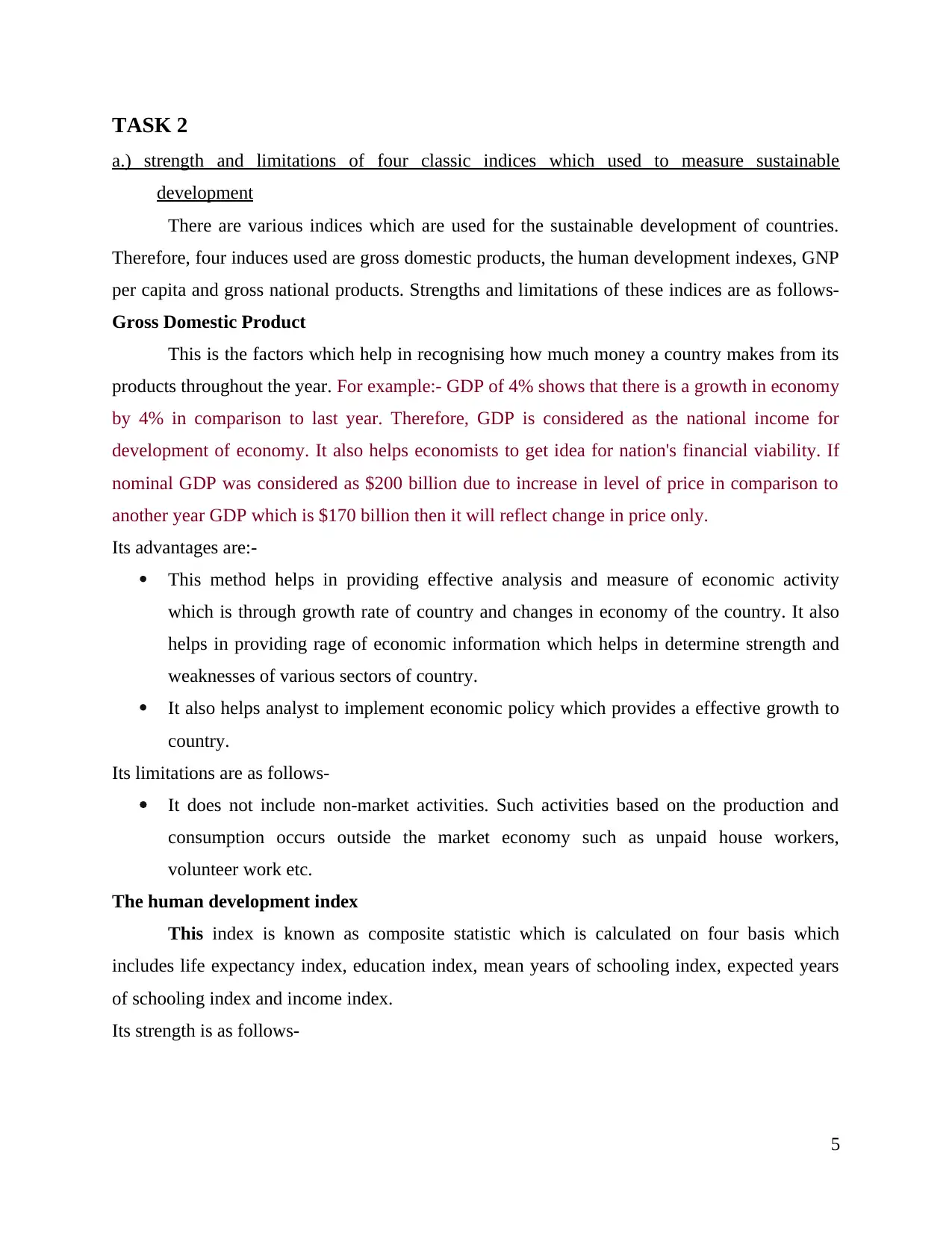
TASK 2
a.) strength and limitations of four classic indices which used to measure sustainable
development
There are various indices which are used for the sustainable development of countries.
Therefore, four induces used are gross domestic products, the human development indexes, GNP
per capita and gross national products. Strengths and limitations of these indices are as follows-
Gross Domestic Product
This is the factors which help in recognising how much money a country makes from its
products throughout the year. For example:- GDP of 4% shows that there is a growth in economy
by 4% in comparison to last year. Therefore, GDP is considered as the national income for
development of economy. It also helps economists to get idea for nation's financial viability. If
nominal GDP was considered as $200 billion due to increase in level of price in comparison to
another year GDP which is $170 billion then it will reflect change in price only.
Its advantages are:-
This method helps in providing effective analysis and measure of economic activity
which is through growth rate of country and changes in economy of the country. It also
helps in providing rage of economic information which helps in determine strength and
weaknesses of various sectors of country.
It also helps analyst to implement economic policy which provides a effective growth to
country.
Its limitations are as follows-
It does not include non-market activities. Such activities based on the production and
consumption occurs outside the market economy such as unpaid house workers,
volunteer work etc.
The human development index
This index is known as composite statistic which is calculated on four basis which
includes life expectancy index, education index, mean years of schooling index, expected years
of schooling index and income index.
Its strength is as follows-
5
a.) strength and limitations of four classic indices which used to measure sustainable
development
There are various indices which are used for the sustainable development of countries.
Therefore, four induces used are gross domestic products, the human development indexes, GNP
per capita and gross national products. Strengths and limitations of these indices are as follows-
Gross Domestic Product
This is the factors which help in recognising how much money a country makes from its
products throughout the year. For example:- GDP of 4% shows that there is a growth in economy
by 4% in comparison to last year. Therefore, GDP is considered as the national income for
development of economy. It also helps economists to get idea for nation's financial viability. If
nominal GDP was considered as $200 billion due to increase in level of price in comparison to
another year GDP which is $170 billion then it will reflect change in price only.
Its advantages are:-
This method helps in providing effective analysis and measure of economic activity
which is through growth rate of country and changes in economy of the country. It also
helps in providing rage of economic information which helps in determine strength and
weaknesses of various sectors of country.
It also helps analyst to implement economic policy which provides a effective growth to
country.
Its limitations are as follows-
It does not include non-market activities. Such activities based on the production and
consumption occurs outside the market economy such as unpaid house workers,
volunteer work etc.
The human development index
This index is known as composite statistic which is calculated on four basis which
includes life expectancy index, education index, mean years of schooling index, expected years
of schooling index and income index.
Its strength is as follows-
5
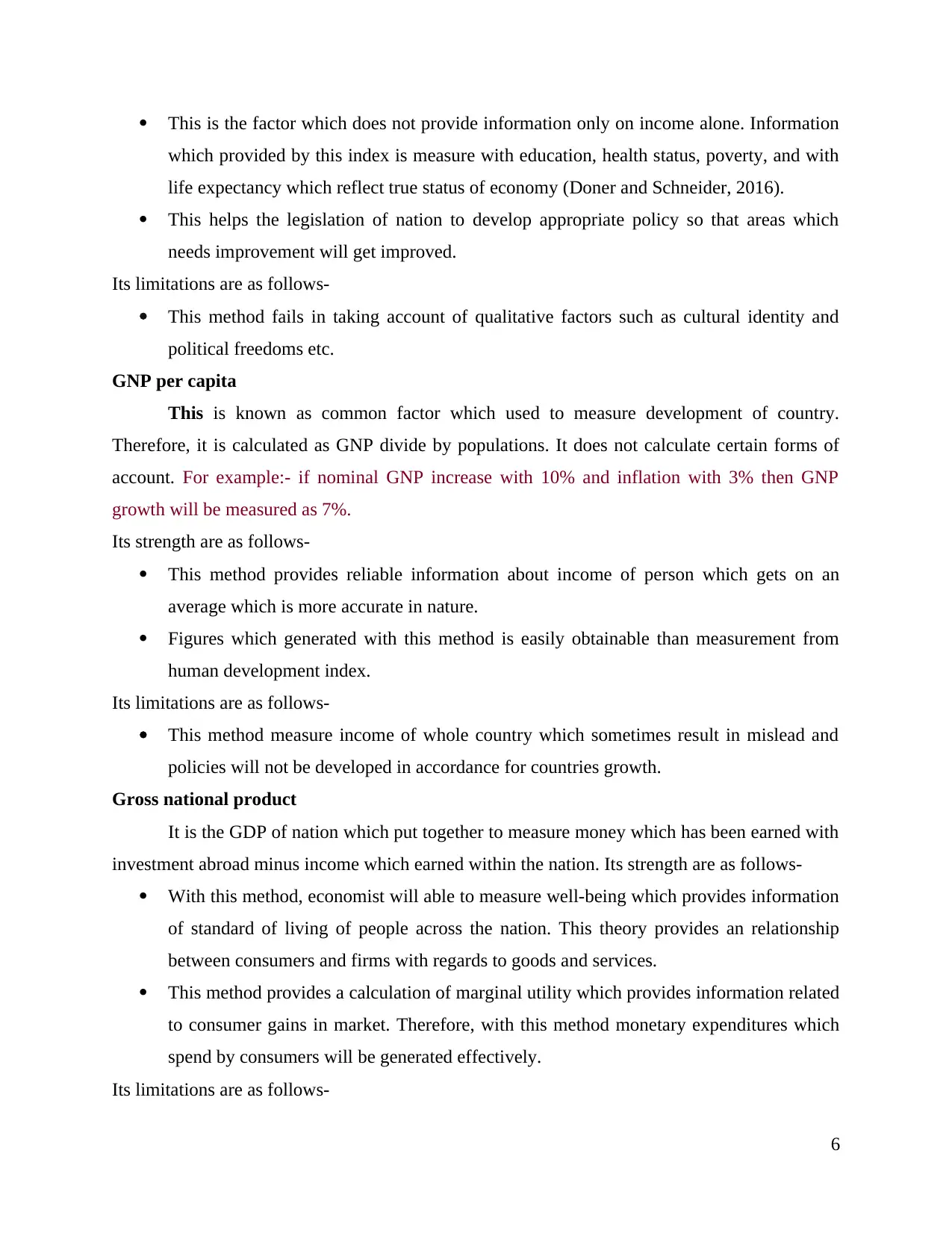
This is the factor which does not provide information only on income alone. Information
which provided by this index is measure with education, health status, poverty, and with
life expectancy which reflect true status of economy (Doner and Schneider, 2016).
This helps the legislation of nation to develop appropriate policy so that areas which
needs improvement will get improved.
Its limitations are as follows-
This method fails in taking account of qualitative factors such as cultural identity and
political freedoms etc.
GNP per capita
This is known as common factor which used to measure development of country.
Therefore, it is calculated as GNP divide by populations. It does not calculate certain forms of
account. For example:- if nominal GNP increase with 10% and inflation with 3% then GNP
growth will be measured as 7%.
Its strength are as follows-
This method provides reliable information about income of person which gets on an
average which is more accurate in nature.
Figures which generated with this method is easily obtainable than measurement from
human development index.
Its limitations are as follows-
This method measure income of whole country which sometimes result in mislead and
policies will not be developed in accordance for countries growth.
Gross national product
It is the GDP of nation which put together to measure money which has been earned with
investment abroad minus income which earned within the nation. Its strength are as follows-
With this method, economist will able to measure well-being which provides information
of standard of living of people across the nation. This theory provides an relationship
between consumers and firms with regards to goods and services.
This method provides a calculation of marginal utility which provides information related
to consumer gains in market. Therefore, with this method monetary expenditures which
spend by consumers will be generated effectively.
Its limitations are as follows-
6
which provided by this index is measure with education, health status, poverty, and with
life expectancy which reflect true status of economy (Doner and Schneider, 2016).
This helps the legislation of nation to develop appropriate policy so that areas which
needs improvement will get improved.
Its limitations are as follows-
This method fails in taking account of qualitative factors such as cultural identity and
political freedoms etc.
GNP per capita
This is known as common factor which used to measure development of country.
Therefore, it is calculated as GNP divide by populations. It does not calculate certain forms of
account. For example:- if nominal GNP increase with 10% and inflation with 3% then GNP
growth will be measured as 7%.
Its strength are as follows-
This method provides reliable information about income of person which gets on an
average which is more accurate in nature.
Figures which generated with this method is easily obtainable than measurement from
human development index.
Its limitations are as follows-
This method measure income of whole country which sometimes result in mislead and
policies will not be developed in accordance for countries growth.
Gross national product
It is the GDP of nation which put together to measure money which has been earned with
investment abroad minus income which earned within the nation. Its strength are as follows-
With this method, economist will able to measure well-being which provides information
of standard of living of people across the nation. This theory provides an relationship
between consumers and firms with regards to goods and services.
This method provides a calculation of marginal utility which provides information related
to consumer gains in market. Therefore, with this method monetary expenditures which
spend by consumers will be generated effectively.
Its limitations are as follows-
6
⊘ This is a preview!⊘
Do you want full access?
Subscribe today to unlock all pages.

Trusted by 1+ million students worldwide
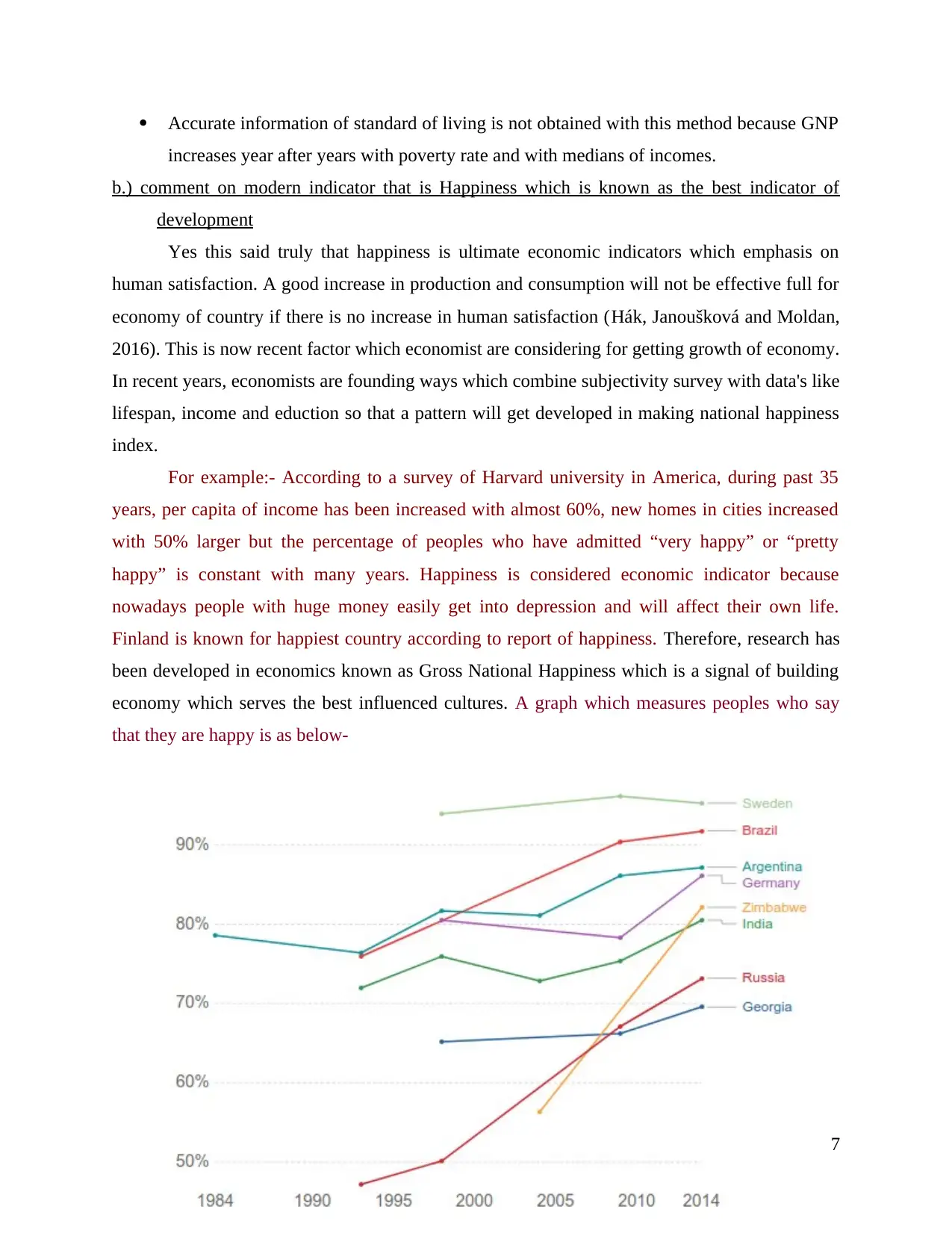
Accurate information of standard of living is not obtained with this method because GNP
increases year after years with poverty rate and with medians of incomes.
b.) comment on modern indicator that is Happiness which is known as the best indicator of
development
Yes this said truly that happiness is ultimate economic indicators which emphasis on
human satisfaction. A good increase in production and consumption will not be effective full for
economy of country if there is no increase in human satisfaction (Hák, Janoušková and Moldan,
2016). This is now recent factor which economist are considering for getting growth of economy.
In recent years, economists are founding ways which combine subjectivity survey with data's like
lifespan, income and eduction so that a pattern will get developed in making national happiness
index.
For example:- According to a survey of Harvard university in America, during past 35
years, per capita of income has been increased with almost 60%, new homes in cities increased
with 50% larger but the percentage of peoples who have admitted “very happy” or “pretty
happy” is constant with many years. Happiness is considered economic indicator because
nowadays people with huge money easily get into depression and will affect their own life.
Finland is known for happiest country according to report of happiness. Therefore, research has
been developed in economics known as Gross National Happiness which is a signal of building
economy which serves the best influenced cultures. A graph which measures peoples who say
that they are happy is as below-
7
increases year after years with poverty rate and with medians of incomes.
b.) comment on modern indicator that is Happiness which is known as the best indicator of
development
Yes this said truly that happiness is ultimate economic indicators which emphasis on
human satisfaction. A good increase in production and consumption will not be effective full for
economy of country if there is no increase in human satisfaction (Hák, Janoušková and Moldan,
2016). This is now recent factor which economist are considering for getting growth of economy.
In recent years, economists are founding ways which combine subjectivity survey with data's like
lifespan, income and eduction so that a pattern will get developed in making national happiness
index.
For example:- According to a survey of Harvard university in America, during past 35
years, per capita of income has been increased with almost 60%, new homes in cities increased
with 50% larger but the percentage of peoples who have admitted “very happy” or “pretty
happy” is constant with many years. Happiness is considered economic indicator because
nowadays people with huge money easily get into depression and will affect their own life.
Finland is known for happiest country according to report of happiness. Therefore, research has
been developed in economics known as Gross National Happiness which is a signal of building
economy which serves the best influenced cultures. A graph which measures peoples who say
that they are happy is as below-
7
Paraphrase This Document
Need a fresh take? Get an instant paraphrase of this document with our AI Paraphraser
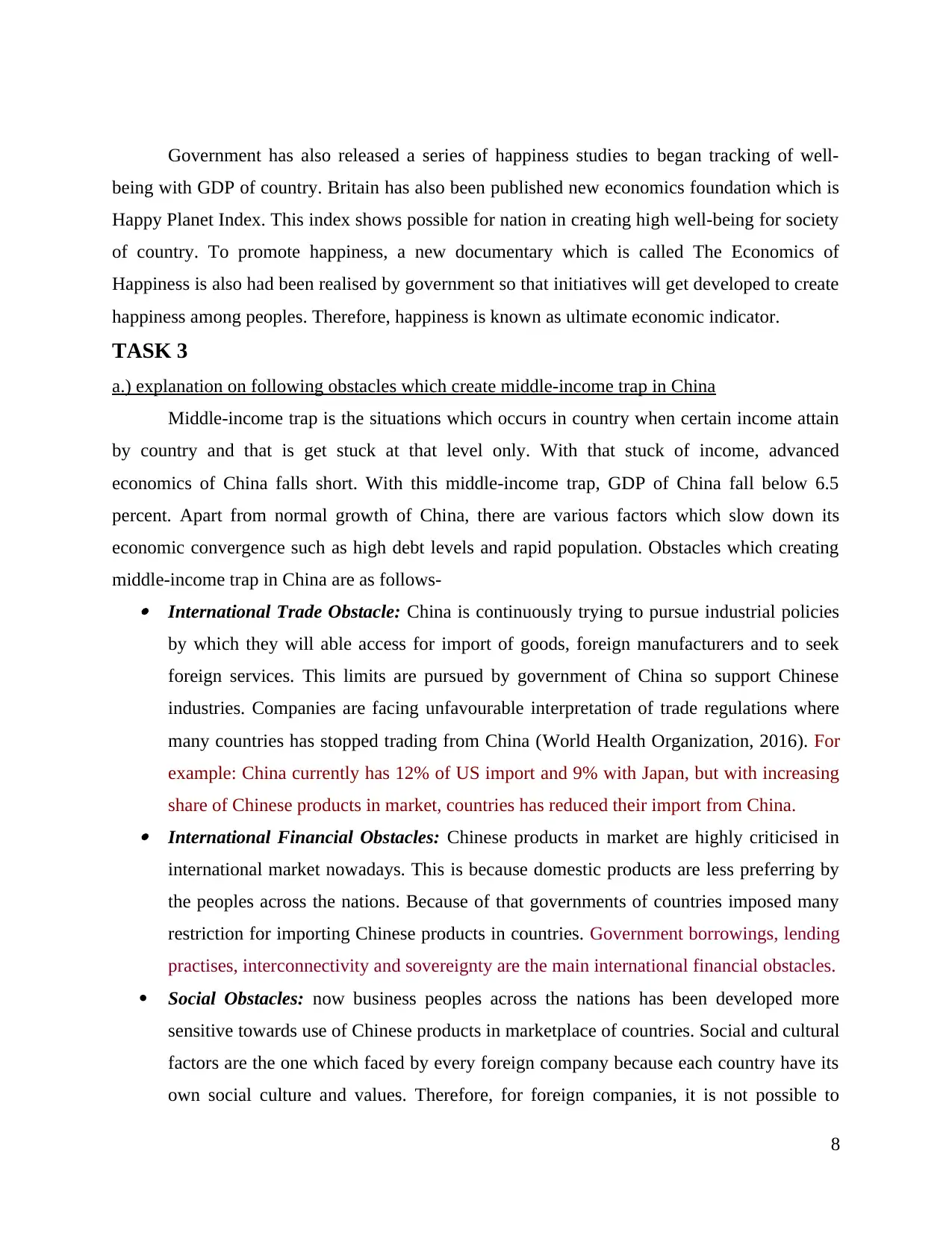
Government has also released a series of happiness studies to began tracking of well-
being with GDP of country. Britain has also been published new economics foundation which is
Happy Planet Index. This index shows possible for nation in creating high well-being for society
of country. To promote happiness, a new documentary which is called The Economics of
Happiness is also had been realised by government so that initiatives will get developed to create
happiness among peoples. Therefore, happiness is known as ultimate economic indicator.
TASK 3
a.) explanation on following obstacles which create middle-income trap in China
Middle-income trap is the situations which occurs in country when certain income attain
by country and that is get stuck at that level only. With that stuck of income, advanced
economics of China falls short. With this middle-income trap, GDP of China fall below 6.5
percent. Apart from normal growth of China, there are various factors which slow down its
economic convergence such as high debt levels and rapid population. Obstacles which creating
middle-income trap in China are as follows- International Trade Obstacle: China is continuously trying to pursue industrial policies
by which they will able access for import of goods, foreign manufacturers and to seek
foreign services. This limits are pursued by government of China so support Chinese
industries. Companies are facing unfavourable interpretation of trade regulations where
many countries has stopped trading from China (World Health Organization, 2016). For
example: China currently has 12% of US import and 9% with Japan, but with increasing
share of Chinese products in market, countries has reduced their import from China. International Financial Obstacles: Chinese products in market are highly criticised in
international market nowadays. This is because domestic products are less preferring by
the peoples across the nations. Because of that governments of countries imposed many
restriction for importing Chinese products in countries. Government borrowings, lending
practises, interconnectivity and sovereignty are the main international financial obstacles.
Social Obstacles: now business peoples across the nations has been developed more
sensitive towards use of Chinese products in marketplace of countries. Social and cultural
factors are the one which faced by every foreign company because each country have its
own social culture and values. Therefore, for foreign companies, it is not possible to
8
being with GDP of country. Britain has also been published new economics foundation which is
Happy Planet Index. This index shows possible for nation in creating high well-being for society
of country. To promote happiness, a new documentary which is called The Economics of
Happiness is also had been realised by government so that initiatives will get developed to create
happiness among peoples. Therefore, happiness is known as ultimate economic indicator.
TASK 3
a.) explanation on following obstacles which create middle-income trap in China
Middle-income trap is the situations which occurs in country when certain income attain
by country and that is get stuck at that level only. With that stuck of income, advanced
economics of China falls short. With this middle-income trap, GDP of China fall below 6.5
percent. Apart from normal growth of China, there are various factors which slow down its
economic convergence such as high debt levels and rapid population. Obstacles which creating
middle-income trap in China are as follows- International Trade Obstacle: China is continuously trying to pursue industrial policies
by which they will able access for import of goods, foreign manufacturers and to seek
foreign services. This limits are pursued by government of China so support Chinese
industries. Companies are facing unfavourable interpretation of trade regulations where
many countries has stopped trading from China (World Health Organization, 2016). For
example: China currently has 12% of US import and 9% with Japan, but with increasing
share of Chinese products in market, countries has reduced their import from China. International Financial Obstacles: Chinese products in market are highly criticised in
international market nowadays. This is because domestic products are less preferring by
the peoples across the nations. Because of that governments of countries imposed many
restriction for importing Chinese products in countries. Government borrowings, lending
practises, interconnectivity and sovereignty are the main international financial obstacles.
Social Obstacles: now business peoples across the nations has been developed more
sensitive towards use of Chinese products in marketplace of countries. Social and cultural
factors are the one which faced by every foreign company because each country have its
own social culture and values. Therefore, for foreign companies, it is not possible to
8
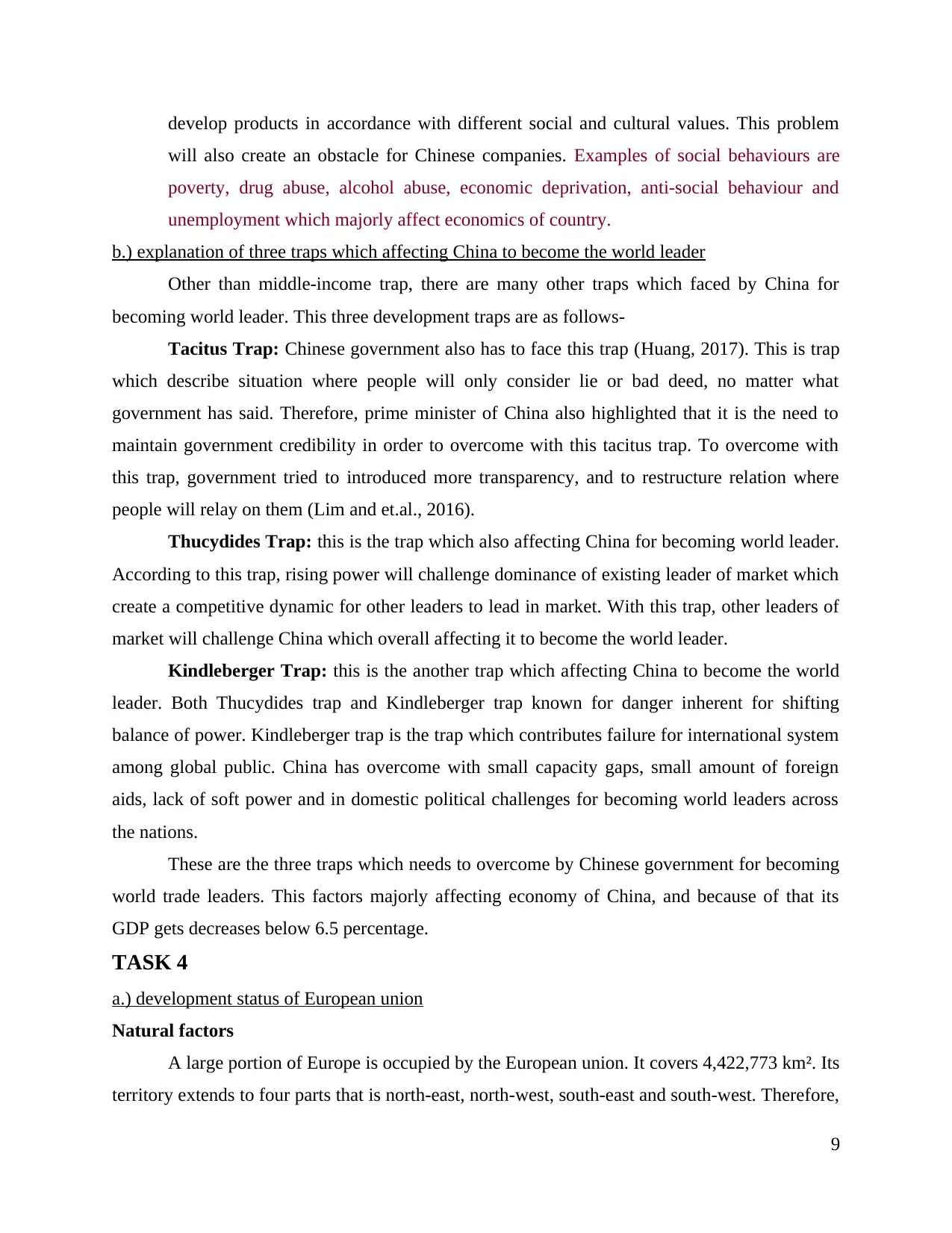
develop products in accordance with different social and cultural values. This problem
will also create an obstacle for Chinese companies. Examples of social behaviours are
poverty, drug abuse, alcohol abuse, economic deprivation, anti-social behaviour and
unemployment which majorly affect economics of country.
b.) explanation of three traps which affecting China to become the world leader
Other than middle-income trap, there are many other traps which faced by China for
becoming world leader. This three development traps are as follows-
Tacitus Trap: Chinese government also has to face this trap (Huang, 2017). This is trap
which describe situation where people will only consider lie or bad deed, no matter what
government has said. Therefore, prime minister of China also highlighted that it is the need to
maintain government credibility in order to overcome with this tacitus trap. To overcome with
this trap, government tried to introduced more transparency, and to restructure relation where
people will relay on them (Lim and et.al., 2016).
Thucydides Trap: this is the trap which also affecting China for becoming world leader.
According to this trap, rising power will challenge dominance of existing leader of market which
create a competitive dynamic for other leaders to lead in market. With this trap, other leaders of
market will challenge China which overall affecting it to become the world leader.
Kindleberger Trap: this is the another trap which affecting China to become the world
leader. Both Thucydides trap and Kindleberger trap known for danger inherent for shifting
balance of power. Kindleberger trap is the trap which contributes failure for international system
among global public. China has overcome with small capacity gaps, small amount of foreign
aids, lack of soft power and in domestic political challenges for becoming world leaders across
the nations.
These are the three traps which needs to overcome by Chinese government for becoming
world trade leaders. This factors majorly affecting economy of China, and because of that its
GDP gets decreases below 6.5 percentage.
TASK 4
a.) development status of European union
Natural factors
A large portion of Europe is occupied by the European union. It covers 4,422,773 km². Its
territory extends to four parts that is north-east, north-west, south-east and south-west. Therefore,
9
will also create an obstacle for Chinese companies. Examples of social behaviours are
poverty, drug abuse, alcohol abuse, economic deprivation, anti-social behaviour and
unemployment which majorly affect economics of country.
b.) explanation of three traps which affecting China to become the world leader
Other than middle-income trap, there are many other traps which faced by China for
becoming world leader. This three development traps are as follows-
Tacitus Trap: Chinese government also has to face this trap (Huang, 2017). This is trap
which describe situation where people will only consider lie or bad deed, no matter what
government has said. Therefore, prime minister of China also highlighted that it is the need to
maintain government credibility in order to overcome with this tacitus trap. To overcome with
this trap, government tried to introduced more transparency, and to restructure relation where
people will relay on them (Lim and et.al., 2016).
Thucydides Trap: this is the trap which also affecting China for becoming world leader.
According to this trap, rising power will challenge dominance of existing leader of market which
create a competitive dynamic for other leaders to lead in market. With this trap, other leaders of
market will challenge China which overall affecting it to become the world leader.
Kindleberger Trap: this is the another trap which affecting China to become the world
leader. Both Thucydides trap and Kindleberger trap known for danger inherent for shifting
balance of power. Kindleberger trap is the trap which contributes failure for international system
among global public. China has overcome with small capacity gaps, small amount of foreign
aids, lack of soft power and in domestic political challenges for becoming world leaders across
the nations.
These are the three traps which needs to overcome by Chinese government for becoming
world trade leaders. This factors majorly affecting economy of China, and because of that its
GDP gets decreases below 6.5 percentage.
TASK 4
a.) development status of European union
Natural factors
A large portion of Europe is occupied by the European union. It covers 4,422,773 km². Its
territory extends to four parts that is north-east, north-west, south-east and south-west. Therefore,
9
⊘ This is a preview!⊘
Do you want full access?
Subscribe today to unlock all pages.

Trusted by 1+ million students worldwide
1 out of 40
Related Documents
Your All-in-One AI-Powered Toolkit for Academic Success.
+13062052269
info@desklib.com
Available 24*7 on WhatsApp / Email
![[object Object]](/_next/static/media/star-bottom.7253800d.svg)
Unlock your academic potential
Copyright © 2020–2025 A2Z Services. All Rights Reserved. Developed and managed by ZUCOL.





